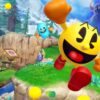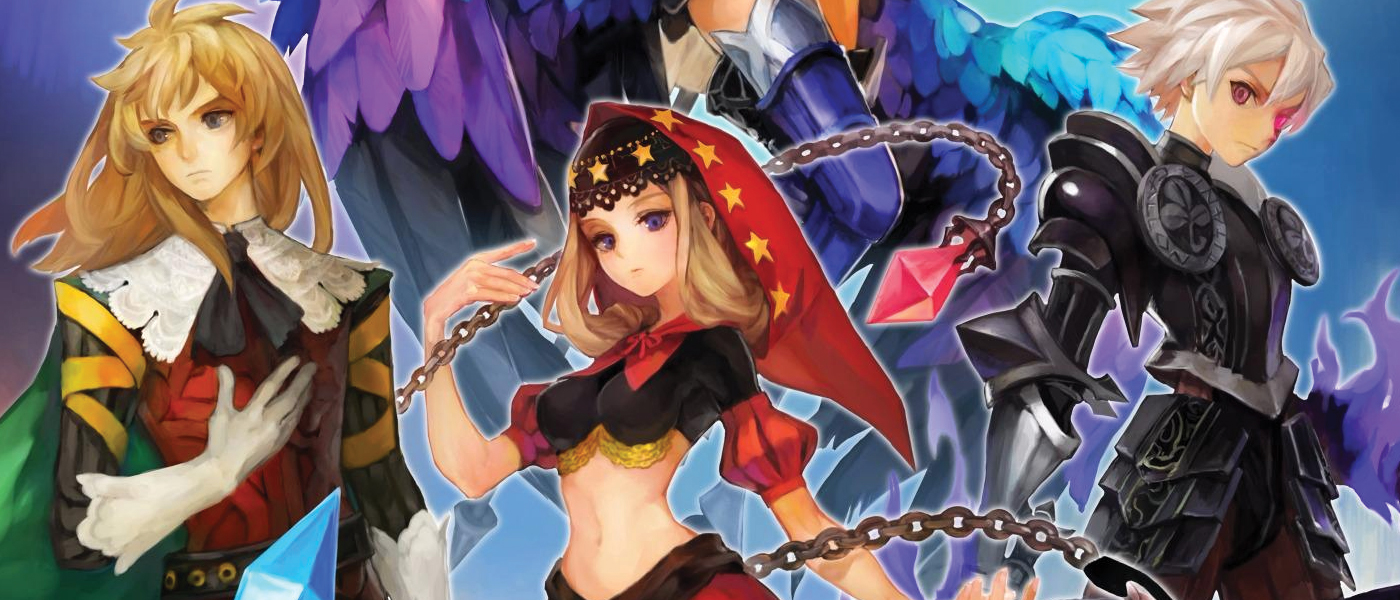Press Start may receive a commission when you buy from links on our site at no extra cost to you.
 Odin Sphere is framed narratively as a series of books read by a little girl called Alice with her cat Socrates, in a delightfully presented opening sequence of her picking a book to read, each revolving around one of five protagonists.
Odin Sphere is framed narratively as a series of books read by a little girl called Alice with her cat Socrates, in a delightfully presented opening sequence of her picking a book to read, each revolving around one of five protagonists.
The main story revolves around the villain Ragnanival, who has invaded in order to seek a magical Cauldron which can create Psypher Crystals, the main source of magic and power in the game. The five books all tell five different viewpoints of differing kingdoms and organisations all vying for power and all fighting to claim the Cauldron for themselves. It’s a grand, sweeping epic tale that spells Armageddon, and it’s a difficult one to comprehend. Coming into the game as a novice, the game doesn’t waste time in introducing new mechanics, lore and characters at a rapid-fire pace. Keeping track of protagonists and enemies is quite difficult, but it’s a fun story that’s presented wonderfully in an artistic sense.
It’s a grand, sweeping epic tale that spells Armageddon, and it’s a difficult one to comprehend. Coming into the game as a novice, the game doesn’t waste time in introducing new mechanics, lore and characters at a rapid-fire pace. Keeping track of protagonists and enemies is quite difficult, but it’s a fun story that’s presented wonderfully in an artistic sense. Odin Sphere looks, for lack of a better phrase, absolutely amazing. For a game that came out on PS2, the original art style still holds up incredibly well. The game’s art style is very reminiscent of Japanese RPG’s, with a bright colour palette and Japanese-built avatars, along with mixing western mythology and throwing in some Norse inspired geometries.
Odin Sphere looks, for lack of a better phrase, absolutely amazing. For a game that came out on PS2, the original art style still holds up incredibly well. The game’s art style is very reminiscent of Japanese RPG’s, with a bright colour palette and Japanese-built avatars, along with mixing western mythology and throwing in some Norse inspired geometries.
I cannot overemphasis how good this game looks- running on a full 1080p resolution at 60fps, the art style is simply sublime here. The 2D backrops are especially stunning- rolling hills, ice caverns and mountains all connect together well, and look amazing. I did however, notice some slowdown during particularly heavy combat scenarios: when there’s huge bosses in the backdrop mixed with smaller enemies in the foreground, it not only gets a bit too chaotic to keep track, but the frame rate does suffer a bit. It’s an unfortunate fault to what could be one of the PS4’s best looking games. Having never played the original on PS2, it’s hard to say how good it looked back then, but it’s safe to say that Vanillaware never was able to exploit the full potential of their art staff. This is no longer a problem, as the PS4 version is easily one of the best looking games of its type on the system. The hand-drawn art style looks absolutely phenomenal, and it’s hard to heap enough praise on what is such a good looking game. Even if you’re not a fan of these style of games, it’s well worth exploring the effort and time that went into creating such an intriguing and beautiful art style.
Having never played the original on PS2, it’s hard to say how good it looked back then, but it’s safe to say that Vanillaware never was able to exploit the full potential of their art staff. This is no longer a problem, as the PS4 version is easily one of the best looking games of its type on the system. The hand-drawn art style looks absolutely phenomenal, and it’s hard to heap enough praise on what is such a good looking game. Even if you’re not a fan of these style of games, it’s well worth exploring the effort and time that went into creating such an intriguing and beautiful art style.
The remake, for the most part, is fantastic, but the English voices aren’t so spectacular. Some line deliveries are downright laughable and it’s shocking how flat some voices are. I fully recommend the original Japanese audio with English subtitles for those wanting the story delivered to them in the perfect way. The gameplay is a simple enough side-scroller Castlevania-esque game- utilizing combos mostly made up of one button presses, mixed with spells, potions and additional contextual input via the directional pad, it’s a simple gameplay system but with additional depth to keep it engaging throughout the length. The combat is fast, frenetic and sometimes chaotic with the amount of assets on-screen, but it’s never unfair and mostly challenging. I found the block system to be a bit unintuitive, as it requires holding down the square button, I found sometimes I would be blocking attacks with finesse and grace, but other times missing frames completely and constantly leaving myself open to damage, which was an annoyance that carried on from the start to finish. The free flow mix of physical attacks and magical abilities that use up resources keeps the combat fresh and exciting, and it’s quite satisfying finishing a combat stage with the heralded S rank, as stages are graded depending on performance and times.
The gameplay is a simple enough side-scroller Castlevania-esque game- utilizing combos mostly made up of one button presses, mixed with spells, potions and additional contextual input via the directional pad, it’s a simple gameplay system but with additional depth to keep it engaging throughout the length. The combat is fast, frenetic and sometimes chaotic with the amount of assets on-screen, but it’s never unfair and mostly challenging. I found the block system to be a bit unintuitive, as it requires holding down the square button, I found sometimes I would be blocking attacks with finesse and grace, but other times missing frames completely and constantly leaving myself open to damage, which was an annoyance that carried on from the start to finish. The free flow mix of physical attacks and magical abilities that use up resources keeps the combat fresh and exciting, and it’s quite satisfying finishing a combat stage with the heralded S rank, as stages are graded depending on performance and times. Levels are split up into smaller segments of gameplay, consisting of either pure combat, exploration or a mix of both, and rest areas. Combat segments are given a star rating indicating how difficult they are in comparison to your current level, and there are many open paths to take in order to grind levels or take alternative routes to the end. Usually, there is a mini-boss that has to be defeated, and a big boss to finish the level, but it is quite open ended and the minimap is reminiscent of Castlevania with the 2D presentation. Additionally, with the 2D style, it isn’t surprising that the D-PAD takes priority over the thumbsticks. The thumbstick directions are fine, but with a 2D game like this, the D-PAD just feels right.
Levels are split up into smaller segments of gameplay, consisting of either pure combat, exploration or a mix of both, and rest areas. Combat segments are given a star rating indicating how difficult they are in comparison to your current level, and there are many open paths to take in order to grind levels or take alternative routes to the end. Usually, there is a mini-boss that has to be defeated, and a big boss to finish the level, but it is quite open ended and the minimap is reminiscent of Castlevania with the 2D presentation. Additionally, with the 2D style, it isn’t surprising that the D-PAD takes priority over the thumbsticks. The thumbstick directions are fine, but with a 2D game like this, the D-PAD just feels right.
Some segments are presented as a continuous loop which may be confusing at start, but soon the flow of the levels and how well they connect will become obvious, not just in a gameplay point of view, but in a thematic point as well. The way these levels are built keep traversal fun and frisk and keeps the flow and momentum moving at a very good pace.
Killing enemies garner EXP, but in lies the main crux of levelling: Psypher. Each character has a Psypher weapon which absorbs Phozons, the game’s version of EXP points. Planting seeds in the ground requires sacrificing Phozons to level up your raw stats, but Phozons are also needed to level up base and additional skills in the skill tree. It becomes a wonderful balancing act of choosing whether to level up or upgrade a particularly useful skill, and it somehow remains quite balanced. There’s also Alchemy elements, mixing potions to heal or attack enemies, which add another layer of gameplay. Not to mention plants, food and cooking, this is just scratching the surface of quite a layered RPG system.
There’s also Alchemy elements, mixing potions to heal or attack enemies, which add another layer of gameplay. Not to mention plants, food and cooking, this is just scratching the surface of quite a layered RPG system.
There are so many additional elements to the game that will enlist another 5000 words to explain in detail, but the crux of the gameplay is that the main combat is fun if a little repetitive, that will definitely start to slog in some parts of the epic 40-50 hour storyline. However, the presentation of the game is wonderful enough to keep the gameplay engaging enough to see to the (bitter) end.
As an additional benefit for anyone picking up the game, the game comes in two modes; Classic and Refined. Refined is basically a remake from the get-go, but the Classic mode retains just about everything from the original PS2 game outside of the upgraded visuals. The refined mode is 100% better than the original but it’s very, very cool that Vanillaware were thoughtful enough to include the Classic mode as well. Fans of the original PS2 version will absolutely love this, and it’s definitely worth exploring Classic to see how much has changed. HD remakes are something I usually ignore, but it’s hard to look over this absolutely masterful redone version of a long forgotten gem. Sadly forgotten from all but the hardcore fans, this PS2 revision has been given new life in a brand new package. The free flowing combat is a joy to play, and the graphical art style is so wonderful to look at, this game is an absolute must-play for any fan of Japanese-style RPG and 2.5D Metroidvania games.
HD remakes are something I usually ignore, but it’s hard to look over this absolutely masterful redone version of a long forgotten gem. Sadly forgotten from all but the hardcore fans, this PS2 revision has been given new life in a brand new package. The free flowing combat is a joy to play, and the graphical art style is so wonderful to look at, this game is an absolute must-play for any fan of Japanese-style RPG and 2.5D Metroidvania games.
The PS4 version of Odin Sphere was primarily tested for the purpose of this review.



